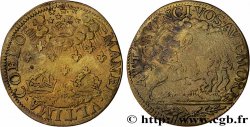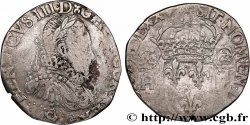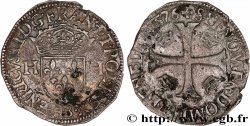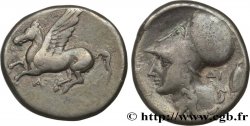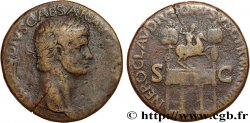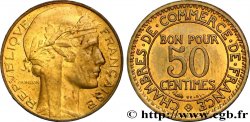Live auction - bry_481697 - HENRY III Double sol parisis, 2e type 1586 Beaucaire
Sie müssen angeschlossen sein und von cgb.fr genehmigt werden, um in einer E-Auktion teilzunehmen.Melden Sie sich an, um zu wetten..Die Kontobestätigungen sind innerhalb von 48 Stunden nach Ihrer Anmeldung gemacht.Warten Sie nicht bis die letzten zwei Tage vor dem Abschluss eines Verkaufs, um Ihre Registrierung abzuschließen. Klickend "BIETEN" verpflichten Sie sich vertraglich, diesen Artikel zu kaufen und Sie nehmen ohne Reserve die allgemeinen Verkaufsbedingungen für den live auctions zu cgb.fr an.
Der Verkauf wird an der Zeit auf der Übersichtsseite angezeigt geschlossen werden. Angebote, die nach der Schließung Zeit empfangen sind, werden nicht gültig.
Bitte beachten Sie, dass die Fristen für die Einreichung Ihres Angebots auf unsere Server können variieren und es kann zur Ablehnung Ihres Angebots entstehen, wenn es in den letzten Sekunden des Verkaufs gesendet wird. Die Angebote sollen mit ganzer Zahl ausgeführt sein, Sie können Kommas oder des Punktes in Ihrem Angebot nicht erfassen. Bei Fragen klicken Sie hier, um einen Blick auf die FAQ Live-Auktionen.
Alle Gewinngebote unterliegen einem Aufschlag von 18 % für Verkaufskosten.
Alle Gewinngebote unterliegen einem Aufschlag von 18 % für Verkaufskosten.
| Schätzung : | 400 € |
| Preis : | 355 € |
| Höchstgebot : | 355 € |
| Verkaufsende : | 31 Juli 2018 15:59:27 |
| Bieter : | 3 Bieter |
Type : Double sol parisis, 2e type
Datum: 1586
Name der Münzstätte / Stadt : Beaucaire
Metall : Scheidemünze
Der Feingehalt beträgt : 319 ‰
Durchmesser : 26 mm
Stempelstellung : 5 h.
Gewicht : 3,29 g.
Seltenheitsgrad : R3
Kommentare zum Erhaltungszustand:
Ce double sol est frappé sur un flan large et irrégulier présentant quelques faiblesses de frappe. Exemplaire recouvert d’une légère patine grise portant de petites taches
N° im Nachschlagewerk :
Vorderseite
Titulatur der Vorderseite + HENRICVS. III. D. G° FRN. ET. P. REX (MG) 1586, (POINT DANS LE C).
Beschreibung Vorderseite H couronnée entre trois lis posés 2 et 1.
Übersetzung der Vorderseite (Henri III, par la grâce de Dieu, roi des Francs et des Polonais).
Rückseite
Titulatur der Rückseite R - .SIT. NOMEN. D[OM]INI. BENEDICTVM., (POINT DANS LE C).
Beschreibung Rückseite Croix cléchée fleurdelisée.
Übersetzung der Rückseite (Béni soit le nom du Seigneur).
Kommentare
Stéphan Sombart et Jean Tastet ont fait le point sur les émissions des ateliers de Beaucaire et de Béziers pendant la Ligue (BSFN, avril 2002, p. 65-67) : “Le 7 juillet 1585, par le traité de Nemours conclu entre Henri III et la Ligue, les édits de tolérance religieuse étaient révoqués et le roi promettait à la Ligue d'expulser tous les Huguenots qui refuseraient de se convertir. Ce traité, enregistré au Parlement de Paris le 18 juillet et au Parlement de Toulouse le 31 juillet, allait renforcer en Languedoc une guerre civile entre deux partis déjà opposés : d'une part les ligueurs languedociens et d'autre part le parti des Politiques, dirigé par Henri de Montmorency et constitué de catholiques et protestants modérés. Henri de Montmorency, seigneur de Damville, est le fils puîné du connétable Anne de Montmorency auquel il succéda dans le gouvernement de Languedoc en mai 1563. Maréchal de France en 1566, Henri de Montmorency prend le titre de duc après le décès de son frère aîné François en 1579. En 1574 déjà, il s'oppose au roi Charles IX puis à son frère Henri III . À la suite du traité de Nemours, devenu le chef des opposants au pouvoir royal tenu en main par la Ligue, il entre à nouveau en révolte après avoir été destitué de son gouvernement de Languedoc. Refusant sa disgrâce, Henri de Montmorency continue à se comporter en gouverneur de Languedoc et procède à la fabrication de monnaies pour financer ses troupes. La Ligue en Languedoc possède l'atelier de Villeneuve-Saint-André-lès-Avignon. Henri III tente aussi de contrôler l'atelier de Montpellier en le transférant à Narbonne, ville ligueuse, mais le personnel de l'atelier composé en majorité de protestants refuse ce transfert et continue à fabriquer pour le compte d'Henri de Montmorency, mais toujours au nom d'Henri III. De son côté, Henri de Montmorency assiège Villeneuve qui refuse de lui obéir et l'atelier de Villeneuve se réfugie en sécurité dans le fort Saint-André d'où il ne sera pas délogé durant toute cette guerre civile. Devant cette détermination, Henri de Montmorency décide alors de concurrencer l'atelier de Villeneuve qui applique les ordonnances royales (qui précisent de fabriquer des doubles sols parisis à 52 au marc) et ouvre un nouvel atelier à Beaucaire en 1585 pour fabriquer des doubles sols parisis à 72 au marc, ainsi qu'il en avait déjà usé à Montpellier. En mai 1586, cet atelier de Beaucaire est transféré à Béziers où il fonctionne dès le 20, avec du personnel venu de Montpellier. Pour cette raison, il avait été supposé que les doubles sols parisis, seules fabrications de Béziers, étaient identifiés par la lettre N, différent de l'atelier de Montpellier . L'atelier de Béziers fut fermé vers le 15 septembre 1586 à la demande et moyennant 15.000 écus des maîtres de l'atelier de Montpellier auxquels il faisait concurrence, atelier lui aussi contrôlé par Henri de Montmorency. Malgré des fabrications que l'on peut supposer abondantes, les monnaies fabriquées dans ces ateliers sont rares et mal connues car les trois ateliers, Villeneuve, Beaucaire puis Béziers ont fabriqué des doubles sols parisis en 1585-1586 en utilisant la même lettre d'atelier, une R. Ce qui permet de différencier les fabrications de ces trois ateliers, en dehors d'un poids plus faible à Beaucaire puis Béziers par rapport à Villeneuve, est donc uniquement les marques de maître et de graveur ainsi que S. Sombart l’indiquait en 1997 "Ces monnaies [de Béziers] n'ont pas été mises en évidence et le différent du maître qui permettrait de les identifier reste inconnu". Cette monnaie, avec un globe crucigère et un point dans les C est attribuée à Beaucaire.
Stéphan Sombart and Jean Tastet reviewed the issues from the Beaucaire and Béziers workshops during the League (BSFN, April 2002, p.. 65-67): “On July 7, 1585, by the Treaty of Nemours concluded between Henry III and the League, the edicts of religious tolerance were revoked and the king promised the League to expel all Huguenots who refused to convert. This treaty, registered in the Parliament of Paris on July 18 and in the Parliament of Toulouse on July 31, was to reinforce in Languedoc a civil war between two already opposed parties: on the one hand the Languedoc leaguers and on the other hand the party of the Politicians, led by Henri de Montmorency and made up of moderate Catholics and Protestants.. Henri de Montmorency, Lord of Damville, is the younger son of Constable Anne de Montmorency, whom he succeeded in the government of Languedoc in May 1563. Marshal of France in 1566, Henri de Montmorency took the title of Duke after the death of his elder brother François in 1579. Already in 1574, he opposed King Charles IX and then his brother Henry III. . Following the Treaty of Nemours, having become the leader of the opponents of the royal power held in the hands of the League, he entered into revolt again after being dismissed from his government of Languedoc. Refusing his disgrace, Henri de Montmorency continued to act as governor of Languedoc and proceeded to manufacture coins to finance his troops.. The League in Languedoc owns the workshop in Villeneuve-Saint-André-lès-Avignon. Henry III also tried to control the Montpellier workshop by transferring it to Narbonne, a League town, but the workshop staff, composed mainly of Protestants, refused this transfer and continued to manufacture on behalf of Henry de Montmorency, but still in the name of Henry III.. For his part, Henri de Montmorency besieged Villeneuve who refused to obey him and Villeneuve's workshop took refuge in safety in Fort Saint-André from where it was not dislodged during this entire civil war.. Faced with this determination, Henri de Montmorency then decided to compete with the Villeneuve workshop which applied the royal ordinances (which specified the production of double sols parisis at 52 per marc) and opened a new workshop in Beaucaire in 1585 to produce double sols parisis at 72 per marc, as he had already done in Montpellier.. In May 1586, this Beaucaire workshop was transferred to Béziers where it operated from the 20th, with staff from Montpellier.. For this reason, it had been assumed that the double Parisian floors, the only ones made in Béziers, were identified by the letter N, different from the Montpellier workshop. . The Béziers workshop was closed around September 15, 1586 at the request and for 15. 000 écus from the masters of the Montpellier workshop with which he competed, a workshop also controlled by Henri de Montmorency. Despite what can be assumed to be abundant production, the coins produced in these workshops are rare and poorly known because the three workshops, Villeneuve, Beaucaire and then Béziers produced double sols Parisis in 1585-1586 using the same workshop letter, an R.. What makes it possible to differentiate the productions of these three workshops, apart from a lower weight in Beaucaire then Béziers compared to Villeneuve, is therefore only the master and engraver marks as well as S. Sombart indicated in 1997: \\\"These coins [from Béziers] have not been brought to light and the difference in the master which would allow them to be identified remains unknown.\\\". This coin, with a cruciform globe and a dot in the C's, is attributed to Beaucaire
Stéphan Sombart and Jean Tastet reviewed the issues from the Beaucaire and Béziers workshops during the League (BSFN, April 2002, p.. 65-67): “On July 7, 1585, by the Treaty of Nemours concluded between Henry III and the League, the edicts of religious tolerance were revoked and the king promised the League to expel all Huguenots who refused to convert. This treaty, registered in the Parliament of Paris on July 18 and in the Parliament of Toulouse on July 31, was to reinforce in Languedoc a civil war between two already opposed parties: on the one hand the Languedoc leaguers and on the other hand the party of the Politicians, led by Henri de Montmorency and made up of moderate Catholics and Protestants.. Henri de Montmorency, Lord of Damville, is the younger son of Constable Anne de Montmorency, whom he succeeded in the government of Languedoc in May 1563. Marshal of France in 1566, Henri de Montmorency took the title of Duke after the death of his elder brother François in 1579. Already in 1574, he opposed King Charles IX and then his brother Henry III. . Following the Treaty of Nemours, having become the leader of the opponents of the royal power held in the hands of the League, he entered into revolt again after being dismissed from his government of Languedoc. Refusing his disgrace, Henri de Montmorency continued to act as governor of Languedoc and proceeded to manufacture coins to finance his troops.. The League in Languedoc owns the workshop in Villeneuve-Saint-André-lès-Avignon. Henry III also tried to control the Montpellier workshop by transferring it to Narbonne, a League town, but the workshop staff, composed mainly of Protestants, refused this transfer and continued to manufacture on behalf of Henry de Montmorency, but still in the name of Henry III.. For his part, Henri de Montmorency besieged Villeneuve who refused to obey him and Villeneuve's workshop took refuge in safety in Fort Saint-André from where it was not dislodged during this entire civil war.. Faced with this determination, Henri de Montmorency then decided to compete with the Villeneuve workshop which applied the royal ordinances (which specified the production of double sols parisis at 52 per marc) and opened a new workshop in Beaucaire in 1585 to produce double sols parisis at 72 per marc, as he had already done in Montpellier.. In May 1586, this Beaucaire workshop was transferred to Béziers where it operated from the 20th, with staff from Montpellier.. For this reason, it had been assumed that the double Parisian floors, the only ones made in Béziers, were identified by the letter N, different from the Montpellier workshop. . The Béziers workshop was closed around September 15, 1586 at the request and for 15. 000 écus from the masters of the Montpellier workshop with which he competed, a workshop also controlled by Henri de Montmorency. Despite what can be assumed to be abundant production, the coins produced in these workshops are rare and poorly known because the three workshops, Villeneuve, Beaucaire and then Béziers produced double sols Parisis in 1585-1586 using the same workshop letter, an R.. What makes it possible to differentiate the productions of these three workshops, apart from a lower weight in Beaucaire then Béziers compared to Villeneuve, is therefore only the master and engraver marks as well as S. Sombart indicated in 1997: \\\"These coins [from Béziers] have not been brought to light and the difference in the master which would allow them to be identified remains unknown.\\\". This coin, with a cruciform globe and a dot in the C's, is attributed to Beaucaire







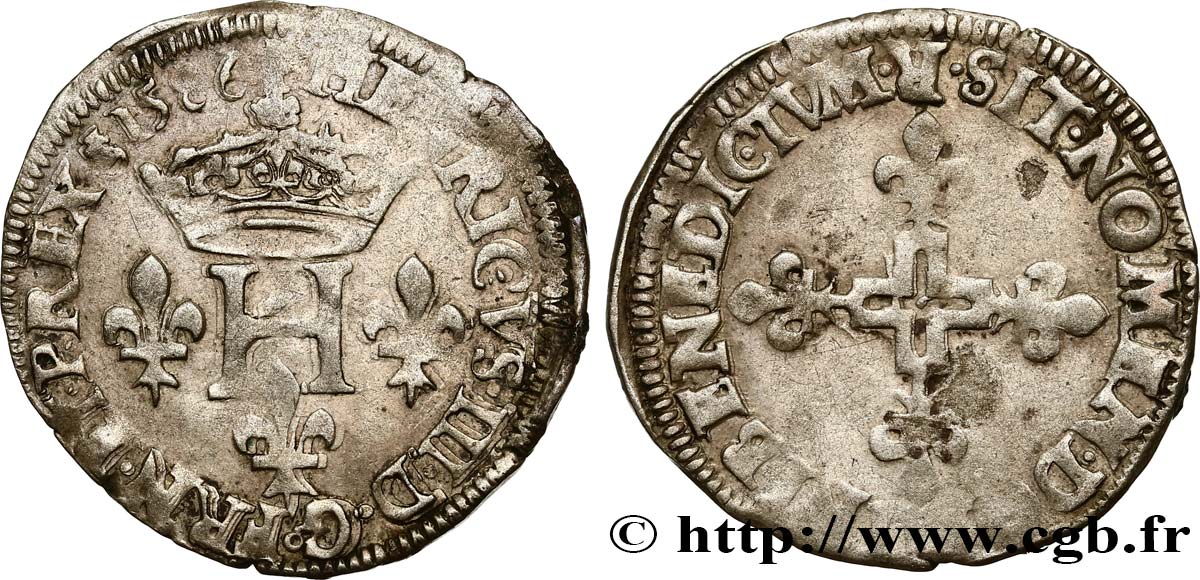
 Berichten über einen Fehler
Berichten über einen Fehler Die Seite drucken
Die Seite drucken Teilen meiner Auswahl
Teilen meiner Auswahl Stellen Sie eine Frage
Stellen Sie eine Frage Einlieferung/Verkauf
Einlieferung/Verkauf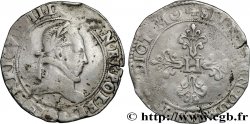
 Details
Details
